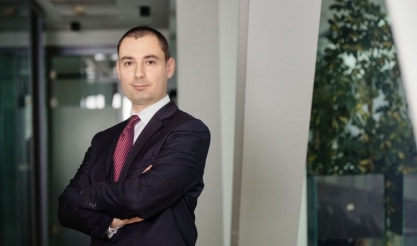
Romania - Opportunities and risks towards energy independence
16 Mai 2022 Mihai Drăghici, Director, Consulting, EY România
The current geopolitical status opened doors to opportunities, but the short-term solutions could represent steps back in terms of achieving decarbonization and sustainable development.

|
The current geopolitical framework forced European countries to redefine their energy relationships and initiate quick steps to become energy independent. For the last ten years, Europe relied heavily on Russian oil & gas, particularly countries such as Germany or Italy, yet this is bound to change. After the conflict between Russia and Ukraine emerged, political discourse has been focused on how Europe must immediately cut off gas imports from Russia and turn to other sources. Therefore, Europe needs to find a quick solution to achieve energy independence, but the road towards this goal is filled with both challenges and opportunities.
Risks emerged in the present context
1. Delayed transition: short-term solutions threatening long-term goals
The current geopolitical status opened doors to opportunities, but the short-term solutions could represent steps back in terms of achieving decarbonization and sustainable development. Thus, several countries took into consideration the reopening of coal mines or increasing their production capacities, despite commitments to reduce GHG emissions. Due to the energy security fears, CE Oltenia is is set to increase its production capacity for 2022. Nevertheless, since the beginning of the year, CE Oltenia has submitted projects from the Modernization Fund worth of 895 million to develop electricity generation capacities, including for renewable projects.
2. Lagging policy & regulatory framework
Moreover, the risks generated by the current conflict are amplified by the delayed use of transition fuel from the Black Sea. The Neptun Deep project is currently on hold, waiting for the modifications on the offshore law. So far, the project for offshore law modifications was submitted in April to the Parliament, being backed by the governing coalition. In the best-case scenario, Romania could begin to extract natural gas from the Black Sea in 2026. Until then, the lack of investments in natural gas production will increase dependence on imports and consequently impact the country’s path towards energy independence.
3. Rising prices
While Europe focuses on implementing long-term measures to gain energy independence, in the short-term the prices will remain high and volatile causing inflationary pressures and other economic side effects. Since we are witnessing in many states a rapid growth of fuel & energy prices, governments will play a huge role in protecting consumers and accelerate the transition towards a more green and independent energy market.
Important opportunities to be explored in redefining the European energy sector
The biggest opportunity is the acceleration of the transition to clean energy and increasing renewable electricity generation will bring expectations such as reducing both fossil fuel use and power market prices. To achieve these goals, the national governments and the European Union should focus on financing renewable energy, energy efficiency and new technologies.
Romania’s potential of low-carbon electricity generation
Within the present political and economic situation, Romania finds itself in a unique position, having the Black Sea as a major perk, which can speed up the switching process to renewable energy. The Black Sea has massive potential for generating wind power – according to a study released by the World Bank, Romania can set up wind farms with a capacity of up to 72.000 MW.
Both offshore and onshore wind, as well as solar energy have strategic importance for Romania’s energy system: by 2030, as part of the National Energy and Climate Plan, Romania aims to deploy an additional wind energy capacity of 2.302 MW and a solar energy capacity of 3.692 MW.
Hydropower also plays a very important role in Romania’s energy mix, representing around 30% of national electricity generation mix. In the long-term, modernizing existing power plants would ensure a constant share of production coming from a renewable source. Given that an important part of the hydropower generation assets is approaching the end of the first lifecycle, a complex refurbishment program needs to be implemented in order for hydropower to remain a central pillar for national electricity generation.
Nuclear power has received increased attention in light of EU’s green taxonomy, being labeled as sustainable energy by the European Comission. Whether this is an intermediate step of the green transition or nor, nuclear is definitely on Romania’s agenda. Considering Nuclearelectrica constantly has a share of nearly 20% in the electricity generation mix, the refurbishment of Cernavoda NPP Unit 1 by 2030, as well as the construction of future nuclear Units 3 and 4 show that nuclear still represents a solid opportunity in diversifying and possibly reaching energy independence.
Moreover, the construction of a small modular nuclear reactor (SMR) in Romania set to be finalized by 2030 is proof of the fact that nuclear is here to stay within the national power system.
New technologies
At the European level, electricity network connectivity is an important topic, with precise goals: a target of at least 15% interconnectivity by 2030. For Romania, the goal is set to at least 15.4%. Through the measures and policies defined in order to develop the electricity infrastructure, Romania can play a major role in European architecture by developing smart grids, becoming an important facilitator. Smart metering represents an important measure, with a lot of potential in terms of achieving a higher level of energy efficiency, as a starting point for the digitalization strategy, benefiting the entire energy ecosystem.
Towards the road to a green Europe, the last instance solution that received attention in recent years and became more relevant within the current situation is the creation of green hydrogen power plants.
On the hydrogen topic, studies based on the Fit for 55 package proposals regarding the use of clean hydrogen in industry and transport show that between 1.470 MW and 2.350 MW of electrolyser capacity will need to be installed in Romania by 2030. When factoring in the additionality principle, this will require between 3 GW and 4.5 GW of new renewables to be installed beside the capacities included in the current National Energy and Climate Plan.
Last, not least, well-established electricity storage solutions such as batteries will also represent an important pillar for ensuring grid stability in the context of the energy transition.
EU financing programmes
In light of the current conflict in the region, EU has launched RepowerEU, a new program that emphasizes the need for action for more affordable, secure and sustainable energy. Urgent action on inflationary tendencies, gas storage for securing next winter’s consumption and immediate measures to cut dependence on Russian gas, such as speeding up renewables permits or increasing solar panls, heat pumps and energy savings are among some of the actions considered within this new energy framework.
This is of course backed up by the Green Deal agenda, as well as the EU funds available for the green transition, including RRF, which included 1.62 billion euros allocated under the Energy component, for investments in wind and solar energy production and storage capacities, green hydrogen production capacities, cogeneration, investments in the entire value chain of photovoltaic batteries, cells and panels, but also to ensure energy efficiency in the industrial sector.
15 billion euros can also be accessed through the Modernisation Fund during 2022-2034 within 8 key programmes targeting investments in renewables, energy infrastructure, gas-fired power plants, nuclear energy, combined heat and power, energy efficiency and biofuels.
EY Energy FiT - the platform that identifies EU funding opportunities for energy-related projects envisaged by investors
EY Romania has developed the EY Energy FiT ("Financing Transition") platform given the strategic importance of investments in the energy sector and the diversity and complexity of programs that will provide financing for this area. EY Energy FiT is a comprehensive online platform that aims to help local companies identify EU financing opportunities for their energy-related projects.
Taking into consideration the on-going urge of development in the energy sector, EY Romania believes that all investors should benefit from access to the best guidance and information and offers a non-complex approach on how companies can benefit from EU Funds and learn more about the importance of Energy Transitioning. The solution is oriented towards organisations who are looking to turn their projects for GHG emissions reduction, renewable energy or energy efficiency into reality.
| Publicitate pe BizLawyer? |
  |
| Articol 1254 / 4609 | Următorul articol |
| Publicitate pe BizLawyer? |
 |

NNDKP, parte din echipa juridică internațională care a asistat Metinvest în achiziția ArcelorMittal Iași
Mușat & Asociații obține o nouă victorie definitivă pentru NUROL într-un proiect strategic de infrastructură rutieră
Apreciată constant de ghidurile juridice internaționale pentru mandatele sofisticate, practica de Capital Markets a CMS România a devenit, prin consistență și profunzime, unul dintre pilonii reputației firmei pe piața locală și un reper important în rețeaua sa regională | De vorbă cu Cristina Reichmann (Partener) despre disciplina pregătirii pentru bursă, finețea aplicării regulilor de piață și forța unei echipe care lucrează articulat, cu roluri clare și obiective aliniate
Record de promovări la Țuca Zbârcea & Asociații: trei noi parteneri și alte 16 numiri interne | Florentin Țuca, Managing Partner: ”Această serie de promovări, una dintre cele mai extinse din istoria noastră, coincide cu aniversarea a 20 de ani de la fondarea firmei, un moment ce reconfirmă valoarea, profesionalismul și dăruirea întregii noastre echipe”
Filip & Company a organizat în parteneriat cu Asociația Studenților în Drept cea de-a zecea ediție a Concursului de negocieri simulate „Teodora Tudose”
MAXIM ̸ Asociații asistă EMSIL TECHTRANS în tranzacția imobiliară încheiată cu METSO pentru o proprietate industrială din Oradea
Kinstellar a consiliat GEA Group, firmă cu operațiuni în peste 150 de țări, cu privire la crearea unui joint venture cu RebelDot, companie de tehnologie din Cluj-Napoca. Echipa care a gestionat proiectul a fost condusă de Rusandra Sandu (Partner) și Mihai Stan (Managing Associate)
Mitel & Asociații dezvoltă o practică de litigii construită în jurul unui nucleu de avocați cu mare experiență, capabilă să ducă la capăt mandate complexe cu impact financiar și reputațional major, într-o piață în care disputele devin tot mai tehnice și mai dure | De vorbă cu Magda Dima (Partener) despre cum se construiește strategia, se evaluează riscurile și se formează generația nouă de litigatori
Echipa de Concurență a RTPR îmbină experiența cu precizia operațională, într-o formulă remarcată în Legal 500 și Chambers | De vorbă cu partenerii Valentin Berea și Roxana Ionescu despre modul de lucru care privilegiază consistența și rigoarea, cu rezultate ce confirmă profesionalismul și anvergura practicii
NNDKP, Popescu & Asociații și ZRVP au cei mai mulți profesioniști listați în Benchmark Litigation - 2025. Ce avocați au intrat în liga „Litigation Stars” și prin ce s-au remarcat firmele aflate în plutonul de forță al practicii
Mușat & Asociații confirmă, în Real Estate, forța unei echipe obișnuite să lucreze sub presiunea timpului și a reglementărilor, menținând proiectele pe un traseu sigur de la due diligence la implementare | De vorbă cu Monia Dobrescu (Partener) despre combinația de rigoare juridică, luciditate în evaluarea riscurilor și creativitate în soluții, într-o periodă plină de provocări
NNDKP confirmă, prin practica de Litigii, că este prima opțiune pentru companiile care au nevoie de reprezentare în dosare cu miză de sute de milioane de euro, în instanțe și arbitraje la curți internaționale | De vorbă cu Emil Bivolaru (Partener Executiv) și Sorina Olaru (Partner) despre combinația dintre strategie, tehnologie și echipe capabile să ducă la capăt dosare complexe cu soluții favorabile, construite pe argumente solide, într-o piață a disputelor sofisticată
-
BizBanker
-
BizLeader
- in curand...
-
SeeNews
in curand...











 RSS
RSS














































